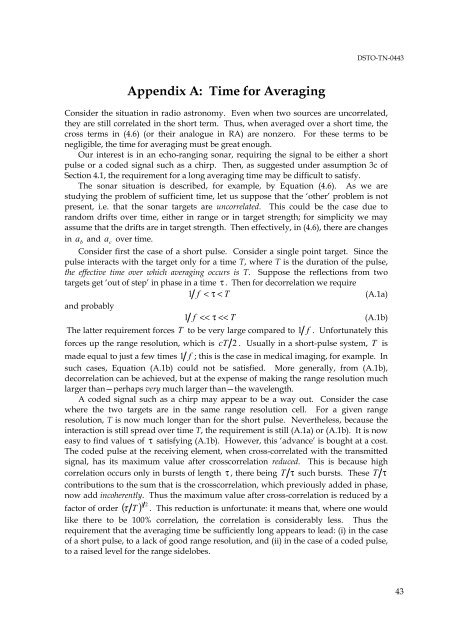Suitability of Correlation Arrays and Superresolution for Minehunting ...
Suitability of Correlation Arrays and Superresolution for Minehunting ...
Suitability of Correlation Arrays and Superresolution for Minehunting ...
Create successful ePaper yourself
Turn your PDF publications into a flip-book with our unique Google optimized e-Paper software.
DSTO-TN-0443<br />
Appendix A: Time <strong>for</strong> Averaging<br />
Consider the situation in radio astronomy. Even when two sources are uncorrelated,<br />
they are still correlated in the short term. Thus, when averaged over a short time, the<br />
cross terms in (4.6) (or their analogue in RA) are nonzero. For these terms to be<br />
negligible, the time <strong>for</strong> averaging must be great enough.<br />
Our interest is in an echo-ranging sonar, requiring the signal to be either a short<br />
pulse or a coded signal such as a chirp. Then, as suggested under assumption 3c <strong>of</strong><br />
Section 4.1, the requirement <strong>for</strong> a long averaging time may be difficult to satisfy.<br />
The sonar situation is described, <strong>for</strong> example, by Equation (4.6). As we are<br />
studying the problem <strong>of</strong> sufficient time, let us suppose that the ‘other’ problem is not<br />
present, i.e. that the sonar targets are uncorrelated. This could be the case due to<br />
r<strong>and</strong>om drifts over time, either in range or in target strength; <strong>for</strong> simplicity we may<br />
assume that the drifts are in target strength. Then effectively, in (4.6), there are changes<br />
in a<br />
b<br />
<strong>and</strong> a<br />
c<br />
over time.<br />
Consider first the case <strong>of</strong> a short pulse. Consider a single point target. Since the<br />
pulse interacts with the target only <strong>for</strong> a time T, where T is the duration <strong>of</strong> the pulse,<br />
the effective time over which averaging occurs is T. Suppose the reflections from two<br />
targets get ‘out <strong>of</strong> step’ in phase in a time τ . Then <strong>for</strong> decorrelation we require<br />
1 f < τ < T<br />
(A.1a)<br />
<strong>and</strong> probably<br />
1 f

















